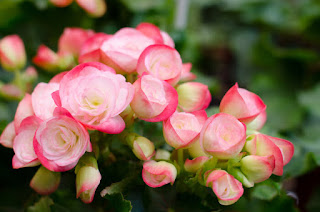
Solidago, commonly called
goldenrods, is a genus of about 100 to 120 species of flowering plants in the
aster family, Asteraceae. Most people are familiar with goldenrod, with its
bright yellow plumes in late summer and early fall. For years it has been
blamed for the hay fever that so many people get at that time of year, perhaps
because the fuzzy goldenrod flowers look so pollen laden. In fact it is the sly,
less conspicuous flowers of ragweed that cause most of the trouble. The many
goldenrod species can be difficult to distinguish, due to their similar bright,
golden-yellow flower heads that bloom in late summer.
People also don’t realize that
there are several different species of goldenrod. Hybrid forms are even sold.
In Europe goldenrod is more treasured as a garden plant that it is here. The best
goldenrods to grow are probably the ones native to your area, though goldenrods
are very adaptable. Most are typically found in rather infertile meadows. In
fact farmers where the soil of an abandoned field needs work if they see
goldenrod growing there. Solidago species are perennials growing from woody
caudices or rhizomes.
 Canada goldenrod “Solidago
canadensis” is a common species that likes meadows slightly moist in spring and
dry in summer, and grows up to four feet. Wrinkled or rough stemmed goldenrod “S.rugosa”
is similar though sometimes taller. Both are hardy to zone 3. Showy or noble
goldenrod “S. speciosa” can grow quite tall and has particularly fine gold
flowers, hardy to zone 5 or 6. Seaside goldenrod “S. sempervirens” hardy to
Zone 5, blooms a long time, even into late fall, and the leaves are evergreen.
It is the best species to grow in seaside locations.
Canada goldenrod “Solidago
canadensis” is a common species that likes meadows slightly moist in spring and
dry in summer, and grows up to four feet. Wrinkled or rough stemmed goldenrod “S.rugosa”
is similar though sometimes taller. Both are hardy to zone 3. Showy or noble
goldenrod “S. speciosa” can grow quite tall and has particularly fine gold
flowers, hardy to zone 5 or 6. Seaside goldenrod “S. sempervirens” hardy to
Zone 5, blooms a long time, even into late fall, and the leaves are evergreen.
It is the best species to grow in seaside locations.  Some species produce abundant
nectar when moisture is plentiful, or when the weather is warm and sunny. Moreover,
goldenrods prefer full sun. They can be very invasive, spreading by creeping
rootstocks and self sowing, especially in moist, fertile soil. They may need to
be controlled in a garden setting but are good flowers for a meadow garden. To propagate,
divide in late winter or early spring. Goldenrods are, in some places,
considered a sign of good luck or good fortune.
Some species produce abundant
nectar when moisture is plentiful, or when the weather is warm and sunny. Moreover,
goldenrods prefer full sun. They can be very invasive, spreading by creeping
rootstocks and self sowing, especially in moist, fertile soil. They may need to
be controlled in a garden setting but are good flowers for a meadow garden. To propagate,
divide in late winter or early spring. Goldenrods are, in some places,
considered a sign of good luck or good fortune.













